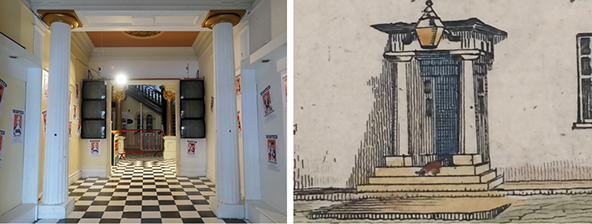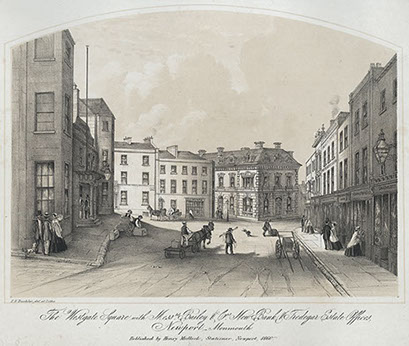

Musket Ball Holes at the Westgate Hotel – Truth or Myth?
The portico and its pillars are all that remain of the ‘second’ Westgate Inn of 1799, and these few remnants of the Georgian past, now stand hidden inside the entrance to the present building. For generations, Newport’s youngsters used to step over the threshold and poke their fingers into the holes in the original pillars. This local ‘rite of passage’ was not possible for over twenty years when the hotel closed its doors. Recently however Our Chartist Heritage and Newport Rising have taken over the hotel and once again visitors can take part in the ritual.
Ray Stroud, in his teaching days, standing near this front entrance, regaled his pupils with stories of the Chartist attack on the Westgate inn, and of the musket balls that had penetrated the building during the battle. On 4th November 1839, this coaching inn witnessed a pitched battle between Welsh Chartists and the soldiers of Queen Victoria. This is History, not a fantasy story. People actually died here that morning.
And pushing our fingers into one or more of these holes, connects us with them.
Out of sight in recent times has led some to doubt and challenge and dismiss as myth the authenticity of the holes. It is suggested that the holes were drilled into the pillars to attach railings or gates, and had nothing to do with the events of 1839.
The evidence has been marshalled by Ray and Olly
What do the records tell us?
During rebuilding in 1884-86, the portico was removed from the old building on Wednesday 17 September 1884. The Monmouthshire Merlin reported (19 September) that, ‘… in the pillar that suffered the most on the occasion of the Chartist riots the workmen came across several roughly-made bullets, one with a nail driven through the centre of it.’
The newspaper added that, ‘…the bullets have doubtless lain where they were found ever since the memorable attack on the hotel 45 years ago.’
Three days later the Weekly Mail confirmed that, in one of the pillars, three bullets had been found.
This was further confirmed by W. N. Johns in his book, The Chartist Riots at Newport: November 1839, published in 1889. He wrote, ‘… there were found four roughly-made bullets or slugs, which had evidently lain in the interior of the pillars since the day of the attack on the building - forty-five years before.’
So the historical evidence from the rebuilding period 1884-86 provides credence for the long held belief that the musket holes are real.
And the forensics?
Newport Museum’s Collections and Engagement Officer, Oliver Blackmore, has inspected the holes with a number of archaeological/material culture experts and most recently through Cadw’s facilitation, a leading forensics and firearms expert has now completed a detailed examination of the holes. A buildings archaeologist has visited the Westgate and is making detailed accurate drawings of the pillars: endoscopy of the holes has also been performed.
The pillars, which are actually made of wood, were originally located outside the entrance door, and it seems they may have been rotated when re-erected on the inside of the new building. All of this indicates that the pillars were in the direct line of fire in 1839 and that they still bear the scars of gunfire.
Will the experts provide a definitive answer to this conundrum?
Find out: The forensic results will be revealed at this year’s annual Chartist Convention to be held at Newport Cathedral on 5 November, when Oliver Blackmore and the historian, Ray Stroud, will speak on this topic.
Book your Tickets for the day, priced at £12 (which includes lunch) – available via Events Page www.newportrising.co.uk










